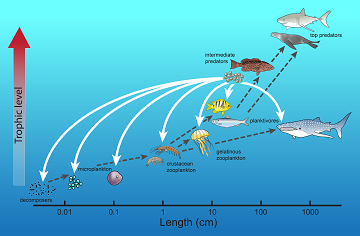350315-egg boon.png

Illustration of how egg boons can change flow of energy in a food web. Broken gray arrows show traditionally recognized pathways. Solid white arrows show flow through egg boons. Credit: Dr. Lee A Fuiman
There’s strength in numbers. Fish and shellfish lay many trillions of eggs every year. That’s important to the health and survival of the species, because most of the eggs never hatch. In fact, most of them never even get the chance — they’re eaten by other creatures. But there’s strength in those numbers as well.The eggs may supply nutrients to the entire marine food chain.
The eggs are rich in essential fatty acids — compounds that are needed for normal development and body function. They sustain the embryos inside the eggs, as well as the young hatchlings.
The main sources of essential fatty acids in the marine environment are algae and the tiny organisms known as plankton. They get eaten by larger organisms, which in turn are consumed by even larger organisms and so on, passing the nutrients all the way up the food chain.
Recent research by scientists at the University of Texas Marine Science Institute, though, suggests that eggs can provide an important secondary supply. And since the eggs are eaten by creatures large and small, they redistribute the fatty acids both up and down the food chain.
A single fish releases many eggs at each spawning. And many fish can spawn at the same time, briefly filling a small area with a high concentration of eggs — a feast for the other organisms around it. At certain times of year, in fact, the eggs can account for a large fraction of the diet of many species — possibly supplying them with enough essential fatty acids to last for months.
This episode of Science and the Sea was made possible by Texas Sea Grant.

